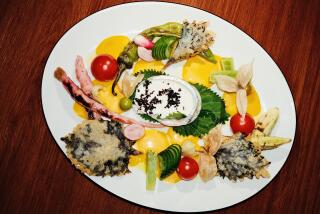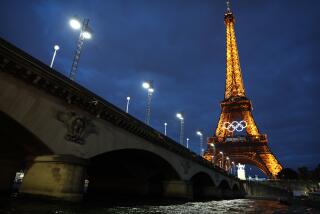Football Fans Can’t Wait to Touch Down Here
NEW ORLEANS — On May 30, 1857, this city’s mayor issued a license to Miss May Baily, who, having paid the tax imposed on “lewd and abandoned women,” was allowed to engage in the world’s oldest profession on the second floor of 423 Dauphine St., the first floor being reserved for drinking and gambling only.
Since its founding by the French in 1718, New Orleans has always been a 24-hour town, short on inhibitions and long on a live-and-let-live outlook. Rampant hedonism is the rule rather than the exception during events such as next Sunday’s Super Bowl or the annual Mardi Gras.
Yet New Orleans remains one of the most charming and exhilarating cities in the United States.
Never mind that French Quarter architecture is pure Spanish (Spain ruled the city from 1762 to 1803), with its filigreed ironwork framing Monterey-style balconies. Or that the twang of local Cajun French drives Parisians straight up the wall.
What really counts is to have a traditional early morning cafe au lait and heavenly beignet cruller at the Cafe du Monde in the French Market; hear six young boys playing better jazz in Jackson Square than you’ll find in many pricey big-city clubs, and sample French-Cajun-Creole restaurants that give the city what many consider the country’s only unique cuisine.
How long/how much? Two to three days, perhaps another, for a run into Bayou country or a trip on the plantation route along the Mississippi. Lodging and dining costs is moderate to high, particularly if you want to stay in a historic house and dine in French Quarter restaurants.
A few fast facts: Best time to visit is spring and fall. Midsummer is hot and humid, and dead of winter is often bone chilling. The public transportation system is very good and taxi fares reasonable in a fairly compact town. There is also a shuttle bus running daily that connects major hotels with the Superdome.
Super Bowl fever is in full sway here, and the hotel situation is hectic. Your best bet is to call the New Orleans Tourist Commission at (504) 566-5068, or a travel agent, since there are still some rooms available.
Our latest check at press time showed accommodations open at Maison D’Ville, 727 Toulouse St., (504) 561-5858; Hotel Columns, 3811 St. Charles Ave., (504) 899-9308; Park View Guest House, 7004 St. Charles Ave., (504) 861-7564, and St. Charles Guest House, 1748 Prytania Ave., (504) 523-6556. The Maison D’Ville is on the expensive side, others are moderate.
Getting settled in: You may also try your luck at these: The Soniat House (1133 Chartres St.; $115 double with breakfasts) will whisk you back to its beginnings in 1829 as the French Quarter town house of a wealthy plantation owner.
Creole and Greek Revival style, the rooms offer an arrangement of English-French-Louisiana antiques, hand-carved headboards, custom fabrics, fine art, four-poster beds, Oriental rugs and handsome armoires.
Le Richelieu (1234 Chartres; $80 to $95 double) also gives you a bit of local history and color, having been turned into a motor hotel from several old row houses and a macaroni factory. There’s a small restaurant serving chops and such, it has a pleasant pool and, as with the Soniat, you’re at the heart of the Quarter.
Monteleone (214 Royal St.; $111 double) is a century-old hotel, family operated, and also has a fine location in the French Quarter. With 600 rooms, this one has the amenities of a large hotel: restaurants, rooftop pool and a lounge with live entertainment.
Regional food and drink: What’s Creole and what’s Cajun?
Briefly, Creole food reflects the cuisine of early French and Spanish settlers, with a dash of African tastes and ingredients added. It’s noted for spicy, yet refined sauces, not necessarily hot. Cajun food is country cooking, robust, peppery hot, often given body by a roux of flour and fat.
Both are marvelous and sometimes overlap into “Louisiana food.”
Creole gumbo probably derives from gombo , an African word for okra, or maybe kombo , a Choctaw Indian word for dried sassafras leaves, both key ingredients. Jambalaya, a rice dish with ham, oysters, sausage, crab or whatever, comes from jambon , the French word for ham.
Moderate-cost dining: Tujague’s (823 Decatur St.) has been turning out superb Creole food for more than a century, making its early reputation by serving dock workers, seamen and butchers from the French Market just across the street. Owner Steve Latter is so pro-Creole that he won’t let a Cajun blackened redfish come out of his kitchen.
Shrimp remoulade might start your six-course set meal, with choice of three entrees. Each course is a revelation in Creole cooking. The gumbo and chicken bon femme in a blanket of garlic were excellent.
Gumbo Shop (630 St. Peter St.) is a 1796 residence in the Quarter that now has two dining rooms, a lovely small courtyard and very moderate prices: crayfish etouffee for $9.95; seafood gumbo, $4.95, jambalaya, $5.95. Their traditional hot bread pudding with whiskey sauce is as good as you’ll find.
Galatoire’s (209 Bourbon St.) is a no-frills place, just one room with ice-cream-parlor chairs, 20 ceiling fans and gooseneck lamps above mirrors that line every wall in the bistro manner.
The oyster-artichoke soup, trout marguery, grilled redfish and pompano amandine will have you humming the Marseillaise for this Gallic outpost.
Going first-class: The Fairmont Hotel (University Place; $150-$190) has seen more debutante parties, carnival balls and political shenanigans than any place in town. When it was the Hotel Roosevelt, Huey Long did most of his governing from a suite here, building a highway from the capital in Baton Rouge straight to the front door.
The hotel has a rooftop pool and tennis courts, as well as the Blue Room supper club and Sazerac Bar, moved from the French Quarter, where the drink--a bourbon cocktail flavored with a bitter liqueur--was invented in 1859.
Every visitor to New Orleans who loves good food owes a debt of gratitude to Archie Casbarian, an Armenian, Swiss-trained hotelier who in 1978 resurrected the once-heralded Arnaud’s (813 Bienville St.) from a culinary depth where “even tourists wouldn’t eat.”
It took $2 million and almost a decade, but today Arnaud’s has regained much of its former glory. The French-Creole menu abounds in such as oysters Bienville , thick shrimp bisque, a piquant remoulade, pompano en croute and quail au chambertin . The desserts are equally tempting, and the service is beyond fault.
On your own: Start by exploring the French Quarter, making sure to visit the market, Cafe du Monde and the riverfront. Then take a streetcar ride on the 155-year-old St. Charles Avenue line for a look at the town’s melange of mansions and its mix of colorful architecture.
You’ll find good jazz at a number of clubs, hotels and in watering holes such as the Court of Two Sisters. Spend a while in Jackson Square watching the street entertainment, perhaps taking a mule-drawn carriage ride from there.
For more information: Call the Greater New Orleans Tourist Commission at (504) 566-5068, or write (1520 Sugar Bowl Drive, New Orleans, La. 70112) for brochures on city sights and entertainment, upcoming events, restaurants, a city map and hotel booklet.
More to Read
Sign up for The Wild
We’ll help you find the best places to hike, bike and run, as well as the perfect silent spots for meditation and yoga.
You may occasionally receive promotional content from the Los Angeles Times.






